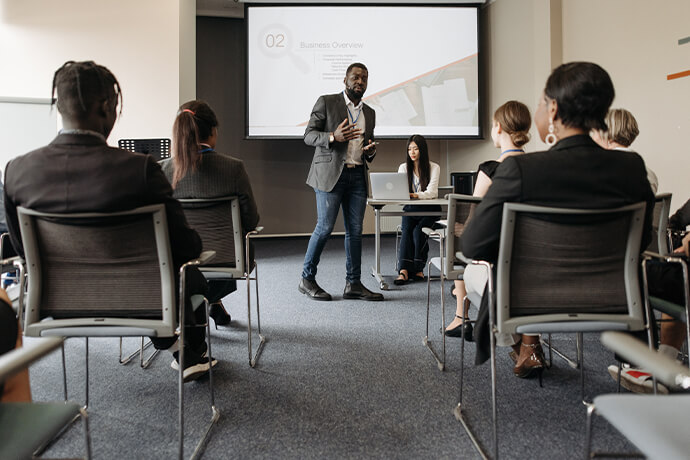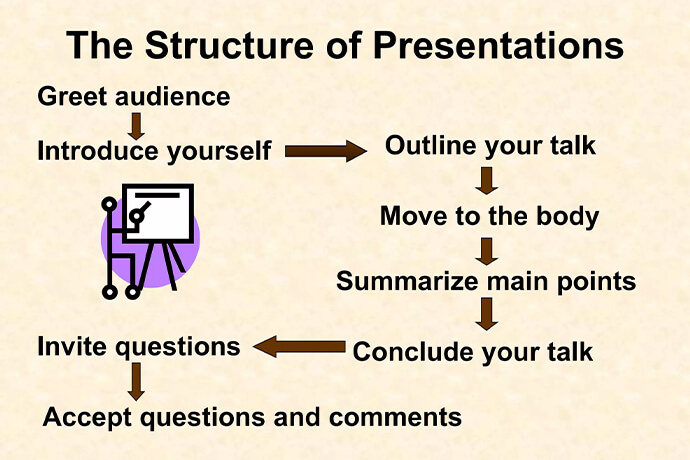 SPEAKERS
SPEAKERS
 TOPICS
TOPICS
Learn the art of structuring presentations for maximum impact with expert strategies. Discover how to leave a lasting impression on your audience.

Have you ever attended a presentation where you found it difficult to understand what the speaker was trying to communicate?
You must have. In fact, we all have.
Then again, you must have also attended great presentations where you felt inspired or well-informed.
Why the difference?
There could be numerous reasons why certain presentations turn out great and some don’t. One very important factor is how you structure a presentation.
Having a clear structure in your presentation is like giving your audience a roadmap. It helps them follow your train of thought, understand the flow of your ideas, and stay engaged without getting lost in a sea of information.
In this blog post we will discuss how to structure a presentation to make it more effective.
So, let’s get started.
Before we get into how to structure a presentation for maximum impact, let’s first look at what a typical presentation structure looks like.

While variations exist, a common structure includes:
You may follow the above framework to create the structure of a good presentation. But, there are a few elements you can add to make your presentations make the maximum impact.
Here are some of the tips you may follow to create more engaging and effective presentations.
The way you structure your presentation plays a pivotal role in creating a lasting impression. This is true regardless of whether you are a seasoned speaker or a newbie looking to develop your presentation skills.
If you are looking for information on how to structure a conference presentation, you may want to incorporate the following.
1. Crafting a Memorable Opening: Hooks to Captivate Your Audience
The success of any presentation hinges on the ability to capture the audience’s attention from the very beginning.
Think about the opening lines of a book or the first few seconds of a movie. Most people make up their mind in the first few seconds whether they would like to continue further. If the beginning is engaging or intriguing, it helps to create a strong desire to continue experiencing the story.
This is where the concept of a "hook" comes into play. A hook is an attention-grabbing element that draws your audience in and compels them to keep listening.
To make your presentations all the more effective, start with a hook. It could be a surprising fact, a thought-provoking question, a relevant quote, or a compelling anecdote that grabs your audience's attention.
Take the example of Amy Tez, actress and communications strategist. In her presentation, The Power of Assertiveness, she starts off by asking “What can an actress teach business leaders?”
Now, that must have got the audience thinking. After all, most people view acting and business are two incredibly different fields.
If you are learning how to structure a presentation speech, consider starting off with a thought-provoking question. Such questions stimulate curiosity and prompts the audience to ponder the topic at hand.
2. Building a Strong Foundation: Organizing Your Content for Clarity
Effective communication largely depends on the clarity and structure of your message. Just as a well-constructed building needs a strong base, your presentation requires a solid structure to ensure your ideas are understood and retained.
Imagine you're constructing a puzzle – each piece needs to fit perfectly to create the complete picture. Similarly, your content must be structured to convey your message seamlessly.
Start by explaining the structure of your presentation upfront, outlining the main points you'll cover.
Organize your content into clear and logical main points. Use a numbered list or a visual representation to help your audience follow along.
Smoothly transition between different points using connecting phrases, so your presentation flows seamlessly.
Mimi Nicklin, the renowned communication specialist, always breaks down her content into well-defined sections, as shown below.
Mimi Nicklin draws inspiration from the Pyramid Principle, an approach that starts with the main message and builds supporting points around it. This ensures that your audience grasps the core message even if they only remember the top level of the pyramid.
Using this method, your content is organized hierarchically, making it easier for your audience to follow and comprehend.
3. The Power of Storytelling: Using Narratives to Convey Your Message
Storytelling is a timeless and powerful tool in communication. It has the capacity of turning mundane information into engaging and memorable narratives. When used effectively in a presentation, storytelling has the remarkable ability to captivate your audience, evoke emotions, and make your message resonate on a deeper level.
One expert who exemplifies the art of storytelling in presentations is Nikki Dean.
Nikki Dean, a skilled presenter and storyteller, harnesses the magic of narrative to make her content relatable and memorable.
She not only aligns the narrative with the theme but often shares personal stories and anecdotes to connect with the audience. She also infuses her stories with emotions that resonates with the audience’s experiences. Emotionally charged narratives evoke empathy and engagement.
Visual communication is another potent tool that can enhance the impact of your presentation. Integrating well-designed slides and multimedia elements can transform complex ideas into easily understandable concepts.
Visuals are processed faster by the brain than text. That’s why visual elements captivate your audience, and make your presentation more memorable.
TEDx Talk speakers use a variety of visual elements, from images, videos, and animals to live demonstrations to engage the audiences.
Remember, the goal of visual communication is to enhance, not replace, your verbal message. By seamlessly integrating well-crafted slides and multimedia, you can create a multi-sensory experience that resonates with your audience and makes your presentation truly impactful.
5. Unforgettable Closings: Strategies to Leave a Lasting Impression
A presentation's closing is your final opportunity to cement your message, inspire action, and ensure your audience departs with a sense of fulfillment. Just as a strong opening captures attention, an unforgettable closing leaves a lasting impression.
And no, it does not have to be something fancy.
Gareth Davies, the CEO of The Presenter Studio and a skilled presenter himself, ends this short video with just “Less is always more,” and that pretty much sums up the video.
To make your presentations even more effective, always end with a clear and compelling call to action. What do you want your audience to do next? Whether it's implementing your suggestions, signing up for a program, or simply pondering your message, guide them towards a specific step.
And like Gareth Davies, always leave your audience with a memorable closing statement that encapsulates your core message. This can be a succinct, impactful phrase that echoes in their minds.
To structure your presentation for maximum effectiveness, follow the below tips:
Creating an effective impact with your presentation involves a combination of strategic planning, engaging content, and skillful delivery. Here are a few tips to help you achieve that impact:
Structuring a presentation speech for maximum impact involves careful preparation, confident delivery, and audience connect.
These tips will help you deliver a presentation speech that leaves a lasting impression:
Conclusion
We hope you like our tips on how to structure a presentation for maximum impact.
Remember, the power of a well-structured presentation lies not only in the information it conveys, but in the connections it forges. It fosters understanding and leaves an indelible impact on your audience.
So, harness these techniques, craft your narrative, and watch as your presentations soar to unparalleled levels of influence.